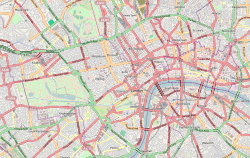
Back متحف التاريخ الطبيعي في لندن Arabic متحف التاريخ الطبيعى فى لندن ARZ ন্যাচারাল হিস্ট্রি মিউজিয়াম, লন্ডন Bengali/Bangla Museu d'Història Natural de Londres Catalan Přírodopisné muzeum (Londýn) Czech Natural History Museum Danish Natural History Museum German Μουσείο Φυσικής Ιστορίας Λονδίνου Greek Muzeo pri Natura Historio de Londono EO Museo de Historia Natural (Londres) Spanish
 | |
 Front façade of the museum in September 2011 | |
| Established | 1881 |
|---|---|
| Location | Kensington & Chelsea, London, SW7 United Kingdom |
| Coordinates | 51°29′46″N 00°10′35″W / 51.49611°N 0.17639°W |
| Type | Natural history museum |
| Visitors | 5,688,786 in 2023[1] |
| Founder | Richard Owen |
| Director | Doug Gurr |
| Public transit access | |
| Website | www |
The Natural History Museum in London is a museum that exhibits a vast range of specimens from various segments of natural history. It is one of three major museums on Exhibition Road in South Kensington, the others being the Science Museum and the Victoria and Albert Museum. The Natural History Museum's main frontage, however, is on Cromwell Road.
The museum is home to life and earth science specimens comprising some 80 million items within five main collections: botany, entomology, mineralogy, palaeontology and zoology. The museum is a centre of research specialising in taxonomy, identification and conservation. Given the age of the institution, many of the collections have great historical as well as scientific value, such as specimens collected by Charles Darwin. The museum is particularly famous for its exhibition of dinosaur skeletons and ornate architecture—sometimes dubbed a cathedral of nature—both exemplified by the large Diplodocus cast that dominated the vaulted central hall before it was replaced in 2017 with the skeleton of a blue whale hanging from the ceiling. The Natural History Museum Library contains an extensive collection of books, journals, manuscripts, and artwork linked to the work and research of the scientific departments; access to the library is by appointment only. The museum is recognised as the pre-eminent centre of natural history and research of related fields in the world.
Although commonly referred to as the Natural History Museum, it was officially known as British Museum (Natural History) until 1992, despite legal separation from the British Museum itself in 1963. Originating from collections within the British Museum, the landmark Alfred Waterhouse building was built and opened by 1881 and later incorporated the Geological Museum. The Darwin Centre is a more recent addition, partly designed as a modern facility for storing the valuable collections.
Like other publicly funded national museums in the United Kingdom, the Natural History Museum does not charge an admission fee.[2] The museum is an exempt charity and a non-departmental public body sponsored by the Department for Culture, Media and Sport.[3][4] The Princess of Wales is a patron of the museum.[5] There are approximately 850 staff at the museum. The two largest strategic groups are the Public Engagement Group and Science Group.[6]
- ^ "British Museum is the most-visited UK attraction again". BBC News. 18 March 2024. Retrieved 18 March 2024.
- ^ "Natural History Museum scraps £9 fee". www.telegraph.co.uk. 24 May 2001. Archived from the original on 11 January 2022.
- ^ "Museum governance". The Natural History Museum. Retrieved 14 March 2010.
- ^ "Natural History Museum". gov.uk. Retrieved 4 April 2023.
- ^ Harrison, Lily; Caldwell, Lindsey (22 April 2013). "Duchess Kate to become patron of three new charities". Today News.
- ^ "Our vision". nhm.ac.uk.
